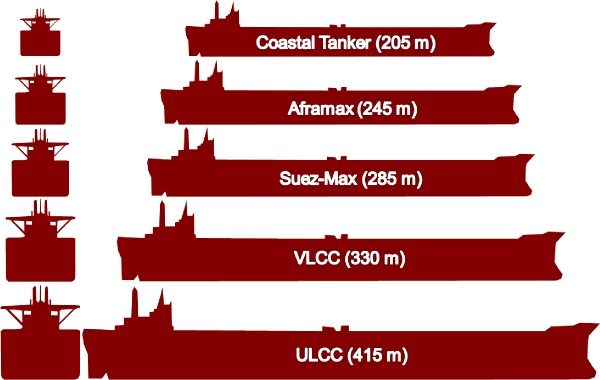Biggest Oil Tankers Overview
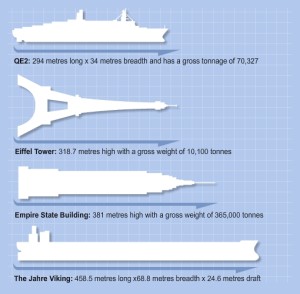 A merchant vessel designed for the transportation of oil is called an oil tanker. The biggest ship in the world, Seawise Giant, belongs to that category. They are divided in two major types – product tanker and crude tanker.
A merchant vessel designed for the transportation of oil is called an oil tanker. The biggest ship in the world, Seawise Giant, belongs to that category. They are divided in two major types – product tanker and crude tanker.
They also can be classified by their sizes. The biggest oil tanker ever is ULCC or ultra large crude carrier.
Annually, 2,000,000,000 metric tons oil are transported by tankers. This is the second efficient method of transport after the pipelines. The transportation with one of the biggest oil tankers adds only between 2 and 4 cents to the price of gallon (3.8 liters).
The biggest oil tankers in service currently are the TI Class. TI Europe and her sister ships TI Africa,TI Oceania and TI Asia were the first ULCC built for the last 24 years.
Biggest Oil Tankers Top 20
The ranking is based on overall length.|
Name |
Length |
Gross Tonnage |
Operator |
Status |
|
| 1 | Seawise Giant | 458.46 m /1,504.1 ft | 260,851 | Orient Overseas Container Line | 1979–2009 |
| 2 | Pierre Guillaumat | 414.23 m / 1,359.0 ft | 274,837 | Cie Nationale de Nav | 1977–1983 |
| 3 | Batillus | 414.22 m / 1,359.0 ft | 273,550 | Société Maritime Shell France | 1976–1985 |
| 4 | Bellamya | 414.22 m / 1,359.0 ft | 274,267 | Société Maritime Shell France | 1976–1986 |
| 5 | Prairial | 414.22 m / 1,359.0 ft | 274,825 | Cie Nationale de Nav | 1979–2003 |
| 6 | Esso Atlantic | 406.57 m / 1,333.9 ft | 247,161 | Esso Tankers Inc. Liberia | 1977–2002 |
| 7 | Esso Pacific | 406.57 m / 1,333.9 ft | 247,160 | Esso Tankers Inc. | 1977–2002 |
| 8 | Nai Superba | 381.92 m / 1,253.0 ft | 198,783 | 1978–2001 | |
| 9 | Nai Genova | 381.92 m / 1,253.0 ft | 188,947 | 1978–2000 | |
| 10 | Berge Emperor | 381.82 m / 1,252.7 ft | 203,112 | Bergesen d.y. & Co | 1975–1986 |
| 11 | Berge Empress | 381.82 m / 1,252.7 ft | 211,358 | Bergesen d.y. & Co | 1976–2004 |
| 12 | TI class (4 ships) | 380 m / 1,247 ft | 234,006 | Tankers International L.L.C | 2002– In Service |
| 13 | Andros Petros | 378.39 m / 1,241 ft | 218,447 | Northern Sealanes Corp | Broken up |
| 14 | Esso Mediterranean | 378.39 m / 1,241 ft | 218,447 | Esso Tankers Inc | Broken up |
| 15 | Coraggio | 378.04 m / 1,240 ft | 205,960 | Pluto S.p.A. Di Navigazio | Broken up |
| 16 | Hilda Knudsen | 378.01 m / 1,240 ft | 203,966 | Knut Knutsen O.A.S. | Broken up |
| 17 | Esso Deutschland | 378.01 m / 1,240 ft | 203,869 | Esso A.G. | Broken up |
| 18 | Jinko Maru | 366.0 m / 1,200 ft | 209,787 | Sanko Line | Broken up |
| 19 | Al Rekkah | 365.99 m / 1,200 ft | 210,068 | Kuwait Oil Tanker Co S.A.K. | Broken up |
| 20 | Aiko Maru | 365.86 m / 1,200 ft | 209,788 | Sanko Line | Broken up |
Biggest Oil Tanker History
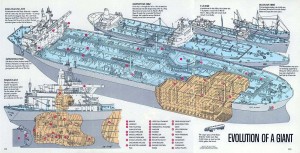 The oil tanker industry started in the 1860s and the first biggest oil tanker was driven by wind sails. The Palmers Shipbuilding and Iron Company were the pioneers in steam engine tankers. The first was the Vaderland, built in 1873.
The oil tanker industry started in the 1860s and the first biggest oil tanker was driven by wind sails. The Palmers Shipbuilding and Iron Company were the pioneers in steam engine tankers. The first was the Vaderland, built in 1873.
The 1870s biggest oil tanker was designed by the Swedish Ludvig and Robert Noble. The tanker was constructed in 1878 and her name was Zoroaster. The biggest oil tanker of that time carried the oil into two iron tanks and had capacity of 242 long tons. She was 184 feet long, her beam was 27 ft and 9 ft draft.
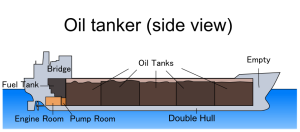 The next big step in the industry was in 1883. The biggest oil tankers were designed with several oil holds. The idea was given by Colonel Henry F. Swan, a British engineer. The first tankers with this systems were the Lumen, Lux and Blesk. The first "modern" oil tanker also was Colonel Henry F. Swan design. The Glückauf was built in 1986 and was the pioneer of the technology of pumping the oil directly into the ship's hull. There was no longer barrels or drums loading.
The next big step in the industry was in 1883. The biggest oil tankers were designed with several oil holds. The idea was given by Colonel Henry F. Swan, a British engineer. The first tankers with this systems were the Lumen, Lux and Blesk. The first "modern" oil tanker also was Colonel Henry F. Swan design. The Glückauf was built in 1986 and was the pioneer of the technology of pumping the oil directly into the ship's hull. There was no longer barrels or drums loading.
The first biggest ship in the begging of the 20th century was the Vandal. Built in 1903 she was the first diesel-electric vessel, designed by the Nobel brothers. The Vandal had a capacity of 750 long tons.
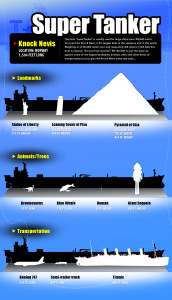 The World War I was the reason for the developing larger ships. The ships had to be bigger to carry more oil for the warships. The USS Maumee, built in 1915, was the first ''underway replenishment' technique'' ship.
The World War I was the reason for the developing larger ships. The ships had to be bigger to carry more oil for the warships. The USS Maumee, built in 1915, was the first ''underway replenishment' technique'' ship.
The biggest oil tankers took major part in the second World War too. The most popular tanker was the T2-SE-A1. The biggest oil tanker of that time had a capacity of 16,613 DWT.
The end of the World War II did not stop the growth of the oil tankers sizes. The biggest oil tanker in that time was the Bulkpetrol. She was build in the end of the 1940s and had capacity of 30,000 long tons.
In 1955 the Bulkpetrol was overpass by Sinclair Petrolore. The biggest oil tanker of that time had a capacity of 56,000 long tons.
The biggest oil tankers were built in the 1970s after the 1973 oil crisis. The biggest oil tanker and biggest ship ever constructed – Seawise Giant was built in 1979.
Oil Tankers Size Categories
The AFRA or average freight rate assessment was developed by Shell Oil and the London Tanker Brokers’ Panel in 1954. The oil tankers were divided to General Purpose, Medium Range and Large range. But after the construction of the biggest oil tankers in the 1970s the system for categorizing the sizes was updated. Currently the tankers are categorized according to flexible market scale.
The scale is base on deadweight metric tons. The biggest oil tankers are the ''supertankers'' or VLCC and ULCC. Their capacity exceeds 250,000 DWT.
|
Class |
Length |
Beam |
Draft |
Deadweight Tonnage |
|
Product tanker |
10,000–60,000 |
|||
| Panamax | 205 m | 29 m | 16 m | 60,000–80,000 DWT |
| Aframax | 245 m | 34 m | 20 m | 80,000–120,000 DWT |
| Suezmax | 285 m | 45 m | 23 m | 125,000 - 180,000 DWT (Suez Canal max capacity) |
| VLCC | 330 m | 55 m | 28 m | 320,000 DWT (Suez Canal can accommodate some in its expanded dimensions) |
| ULCC | 415 m | 63 m | 35 m | Over 320,000 DWT, some reach over 550,000 DWT |
